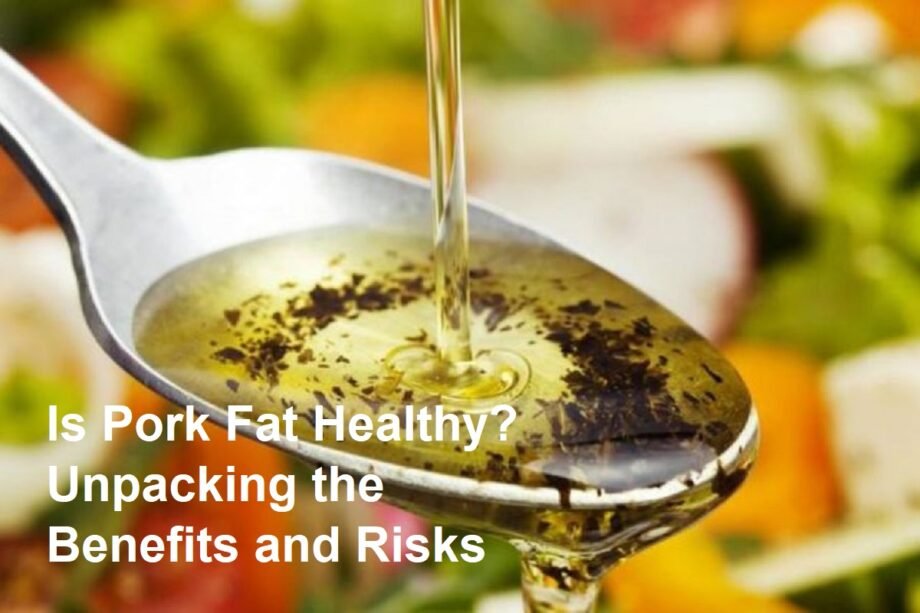What Is Pork Fat (Lard)?
Pork fat, or lard, is rendered fat from pigs. Historically used in global cuisines, it fell out of favor with the rise of vegetable oils. Recently, it’s regained attention as diets like keto and paleo embrace animal fats. But is it truly healthy? Let’s break down the science.
Nutritional Profile of Pork Fat
Lard’s composition influences its health effects:
- Fats:
- Monounsaturated (48%):Heart-healthy fats like oleic acid (also in olive oil).
- Saturated (39%):Controversial; linked to LDL cholesterol but debated in modern science.
- Polyunsaturated (13%):Includes omega-6 fatty acids.
- Vitamins:Rich in vitamin D (second only to cod liver oil) and vitamin E.
- Cholesterol:95mg per tablespoon (moderate vs. butter’s 30mg).
Potential Health Benefits
- Stable Cooking Fat:
- High smoke point (370°F/188°C), making it safer for frying than seed oils (e.g., canola), which oxidize easily.
- Vitamin D Source:
- Supports bone health and immunity. 1 tbsp provides ~1,000 IU (50% of daily needs).
- Heart Health?
- Oleic acid may reduce inflammation and LDL (“bad”) cholesterol when replacing trans fats.
- Zero Carbs:
- Fits low-carb/keto diets as a pure fat source.
Health Risks and Concerns
- Saturated Fat Debate:
- Excess intake may raise LDL cholesterol, a heart disease risk factor. Moderation is key.
- Omega-6 Content:
- High omega-6 to omega-3 ratio (10:1) could promote inflammation if unbalanced.
- Quality Matters:
- Conventional lard:From grain-fed pigs may contain pesticide residues.
- Pasture-raised lard:Higher in vitamin D and omega-3s.
- Calorie Density:
- 115 calories/tbsp; overconsumption aids weight gain.
Pork Fat vs. Other Fats
| Fat Type | Pros | Cons |
| Lard | High smoke point, vitamin D | Saturated fat content |
| Butter | Rich flavor, vitamins A/E/K2 | Low smoke point, higher cholesterol |
| Coconut Oil | MCTs for energy, antimicrobial | Very high saturated fat (90%) |
| Olive Oil | Proven heart benefits, antioxidants | Low smoke point (unsafe for frying) |
Using Pork Fat Wisely
- Choose Wisely:Opt for pasture-raised, non-hydrogenated Avoid industrially processed versions.
- Balance Fats:Pair with omega-3 sources (fatty fish, flaxseeds) to counter omega-6 imbalance.
- Moderation:Limit to 1–2 tbsp/day within a diverse diet.
- Cooking Tip:Ideal for frying, roasting, or baking flaky pastries.
Expert Consensus
- American Heart Association:Prioritize unsaturated fats (olive oil, avocados) but allows saturated fats at ≤13g/day (e.g., 1 tbsp lard = 5g saturated fat).
- Studies:
- A 2015 British Medical Journalreview found no direct link between saturated fat and heart disease, but emphasized food context (e.g., unprocessed lard vs. bacon).
- Research in Lipids(2017) noted lard’s oleic acid supports healthy cholesterol ratios.
The Verdict
Pork fat isn’t a “superfood,” but it’s not a villain either. In moderation, quality lard offers unique benefits (vitamin D, cooking stability) and fits ancestral diets. However, those with heart disease or cholesterol issues should limit intake and consult a doctor.
Final Tip:
Diversity is key. Rotate lard with olive oil, avocado oil, and omega-3-rich fats for optimal health.









